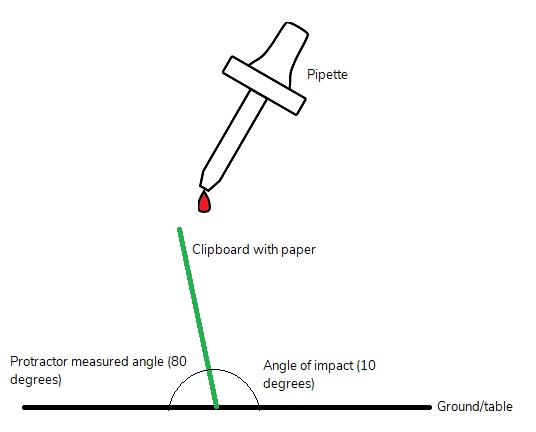Edit
Delete
Physics of Blood Spatter Analysis - Angle of Impact
The Adventure
Delve into the physics that dictates how blood patterns form on surfaces when impacted by only gravity and the angle of impact.
Plan
- Investigate how gravity affects fluids and fluid dynamics.
- Investigate blood spatter pattern analysis (BSA) and how it is used in criminal investigations.
- Read the safety information and discuss with your leaders or another appropriate adult what safety equipment, precautions, and supervision may be required. Ensure that you have these safety measures in place before starting the ‘Do’ section.
- Gather all the equipment that you need to investigate the effects of angle and drop distance on the pattern made from dropping blood. You will need the following equipment: water, glucose syrup, cornflour, red food colouring, blue food colouring, a small bowl, a spoon, a tablespoon, a ruler, a protractor, some white paper, a clipboard or other sturdy board, a pen, a pipette, and a drop sheet to protect the surrounding area.
Do
- Make up your blood replicate by mixing the following together in a small bowl:
a. One and a tablespoon of cornflour
b. One tablespoon of water
c. Two tablespoons of glucose syrup
d. Two drops of red food colouring and one drop of blue food colour.
These quantities can be amended during production as needed to make the fake blood as realistic looking as desired. - Set up your experiment area ensuring you have placed the necessary protecting equipment down to protect the ground or table against damage.
- Attach a piece of paper to a clipboard - or other suitable board - and tape of have another patrol member hold the bottom of the board to a table or the ground.
- Using a protractor, set the board to an angle of 80° from the table to allow for an angle of impact of 10°. You are experimenting with how the angle of impact changes the blood pattern so the angle of the board will change but you will be dropping the blood consisently at a 90° to the ground, as shown in the below diagram.

- Allow a single drop of blood replicate to fall from about 30 cm above the board.
- Repeat with two more drops, moving the pipette slightly to one side before each drop to prevent the drops from overlapping.
- Repeat steps 4 to 7 to create drop patterns with angles of impact of 30°, 50°, 70°, and 90° with a new sheet of paper each time. Note that the “blood” will still be wet so take care when moving and placing the pages so as to not affect your samples.
- Compare the size, shape, and run distance of each drop by measuring the length and width of each drop.
Review
- How did the drop patterns change depending on the angle of impact? What do you think this could tell us in a forensics sense? In what ways do you think the angle of impact may change in a crime scene if surfaces are flat or at 90°.
- What effect do you think altering the blood replicate recipe might have on the drop patterns?
- What did you enjoy most about your blood spatter pattern investigations? What did you learn?
- What other factors do you think may impact blood pattern?
- Do you think that patterns will vary depending on the surface that the blood is being dropped onto? Why or why not?
Safety
- This activity uses replica blood which some youth members may find disturbing.
Variations
- This challenge card can pair well with other forensic science-based challenge cards such as other challenge cards in the‘Figuring Out Fingerprints’ series, Who Wrote It? Paper Chromatography, and Soil pH Testing, to create a forensics program or a‘Whodunit’ night.
- Investigate other angles of impact and factors and how they interplay with each other.
- Investigate other surfaces for blood drops. Do blood drops look the same on paper as they do tiles or glass?
- Depending on the section and challenge area used, this challenge card can also be paired with a police station visit or someother law enforcement related community involvement.
























